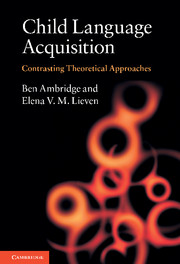Book contents
- Frontmatter
- Contents
- List of figures
- List of tables
- List of boxes
- List of summary tables
- Preface
- Acknowledgements
- 1 Introduction
- 2 Speech perception, segmentation and production
- 3 Learning word meanings
- 4 Theoretical approaches to grammar acquisition
- 5 Inflection
- 6 Simple syntax
- 7 Movement and complex syntax
- 8 Binding, quantification and control
- 9 Related debates and conclusions
- Notes
- References
- Author index
- Subject index
2 - Speech perception, segmentation and production
Published online by Cambridge University Press: 05 June 2012
- Frontmatter
- Contents
- List of figures
- List of tables
- List of boxes
- List of summary tables
- Preface
- Acknowledgements
- 1 Introduction
- 2 Speech perception, segmentation and production
- 3 Learning word meanings
- 4 Theoretical approaches to grammar acquisition
- 5 Inflection
- 6 Simple syntax
- 7 Movement and complex syntax
- 8 Binding, quantification and control
- 9 Related debates and conclusions
- Notes
- References
- Author index
- Subject index
Summary
Introduction
When we hear speech, a stream of sound enters the auditory system. From this stream, any adult who is a native speaker of that language can virtually instantly identify sound sequences that allow them to understand what is being said. They can also produce these sounds to convey meaning. The question of how this is done is by no means resolved for adult speech perception. But explaining how an infant learning a first language identifies and produces the units of that language presents even more difficulties. This issue divides into two main questions. First, how does the infant work out what are the meaningful sounds of the language and second, how does the infant connect these same meaningful sounds to the movements of the articulators (e.g. tongue, lips) needed to produce them? In this chapter, we first outline the basic acoustic and articulatory features of speech and then, in Section 2.3, children's learning of the sounds of their language. Here, the main debate we consider is whether or not children build the phonemic inventories on the basis of innate distinctive features – a clearly nativist position. The constructivist alternative is that the acoustic variability between phonemes that are analysed as having the same features means that the phonemic inventory, and the articulatory contrasts that underpin it, have to be built bottom-up from the input. Section 2.4 considers how children segment the speech stream into words, phrases and clauses.
- Type
- Chapter
- Information
- Child Language AcquisitionContrasting Theoretical Approaches, pp. 13 - 60Publisher: Cambridge University PressPrint publication year: 2011



